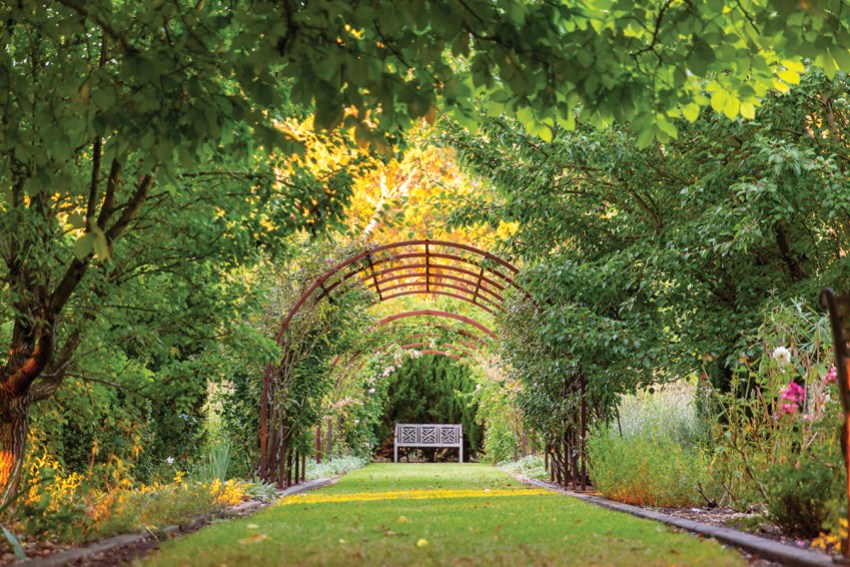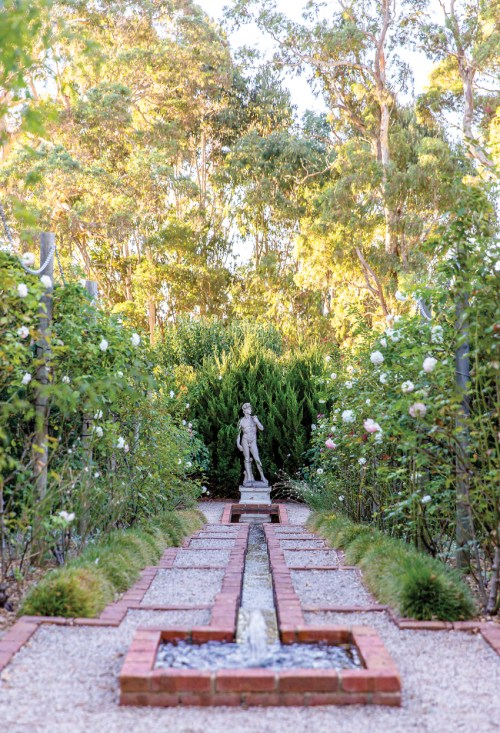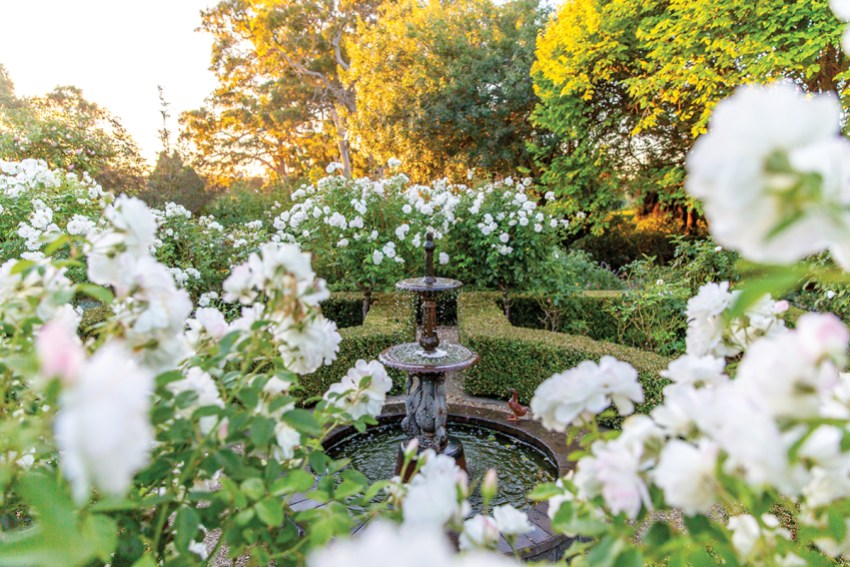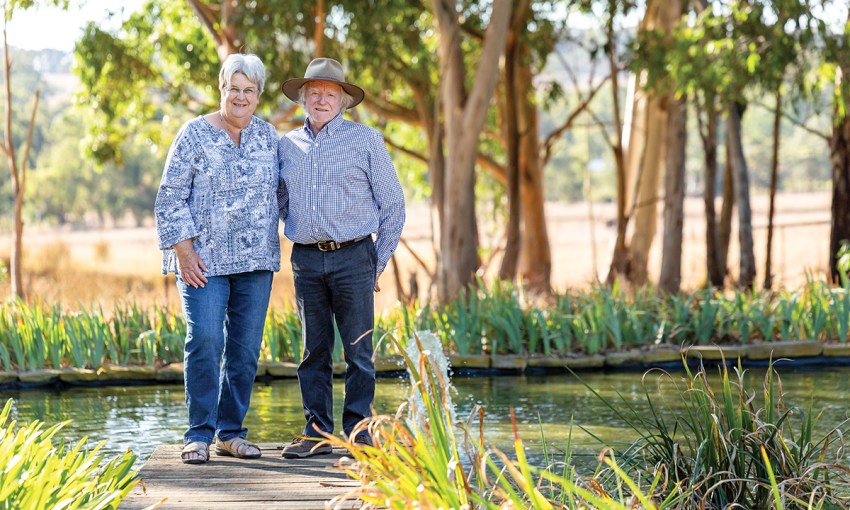Created in only a decade – with plenty of blood, sweat and tears – Sue and Jim Smith’s two-hectare Littlehampton garden is a true marvel of perseverance that now serves a greater purpose in memory of a beloved friend.
The determined gardeners
From the street, the humble frontage of Sue and Jim Smith’s Littlehampton property belies the wondrous and expansive gardens that lie beyond. As SALIFE enters the property through Jim’s hand-built stone walls and down the long, sweeping driveway lined with an avenue of mature trees and box hedges, it feels as if you’ve suddenly entered a botanic garden.
A park-like woodland is revealed, with ash, plane trees and golden elms that stir gently in the autumn breeze, with vast gardens dotted with statues, water features and rose-enveloped arbours. This garden comes alive in summer with the colours of annuals, but today, the trees are beginning to don their autumn coats.
The retirees greet SALIFE at their front door, which is bordered by a perfect Japanese Zen garden.
“A lot of people comment that it does feel like a botanic garden here,” Sue says.
The sprawling gardens appear as if they were established decades ago but, as the couple explains, the two-hectare property was mostly bare when they purchased it 10 years ago. Today, Jim and Sue’s garden contains more than 1000 roses, 20,000 bulbs and some 400 trees. Of particular interest is a trickling water rill, built by Jim, and an English walled garden.
The garden is named “Drouin” and what makes it particularly special is that the retired couple has transformed the expansive two-hectare property by themselves. It’s a full-time, ongoing project for them. The perseverance and drive to keep on top of the maintenance is heroic given Sue and Jim are now in their early 70s. Yet, the spritely pair credit gardening with keeping them in good health, both physical and mental.

“You keep active because there’s so much to do. Gardens have a lot to offer for mental health reasons,” Sue says. “When you’ve had a bad day, you can feel much better after going out in the garden, pulling up a few weeds and just zoning out. You just don’t seem to worry so much.”
None of the property’s previous owners were gardeners. “If you can imagine, it was all open land right through to the paddocks next door, with no lawns, and all covered in cape weed,” explains Sue. “We were lucky that there was a framework of established trees, especially the golden elms, which I love.”
Given that Sue and Jim were close to retirement when they took on the enormous challenge of establishing two hectares of gardens from scratch, a few eyebrows were raised, particularly from their close friend, Jeanette Burgess.
“When we purchased this property, Jeanette said: ‘Are you crazy? Why would you want five acres when you’re just about to retire?’. She was very upfront and honest and that’s what we loved about her. When she started to see what we were doing, she came along for the ride,” says Sue.
Jeanette, who had established several gardens of her own, became closely involved in the development of Drouin garden, regularly visiting to provide advice. Sadly, she died from complications of motor neurone disease in early 2021, and the garden today contains many reminders of Jeanette, as well as features designed in her memory.
“She was our mentor, who we miss very much,” says Sue.

Sue and Jim open their garden to the public every two years as part of the SA Open Gardens Scheme. They will open their garden this November, raising money for motor neurone disease research.
“We’re honouring Jeanette’s memory by raising money for charity and I think she would be over the moon. It’s something I’m very passionate about,” says Sue.
Sue is president of The Hills Green Thumbs Garden Club and hosts regular workshops where members propagate plants to be sold at the open garden events.
“We usually sell more than $3000 worth of plants,” Sue says. Impressively, each open garden at Drouin raises more than $10,000, and is all donated to charity.
“When we first bought the property, I had visions of having a garden to share with people, something they could enjoy. It is very rewarding. People tell you what they like about the garden, ask you questions, and take away ideas,” Sue says.
The couple has propagated hundreds of plants, helping to keep costs down. Sue loves roses, and Jim loves irises, so there are hundreds of both.

“It’s grown organically. We didn’t plan it on paper, we just came up with things as we went along. Some people say it’s a show garden, but I think it’s a gardener’s garden that other people can take ideas from,” says Sue.
Drouin is many different gardens within one. There’s a “secret garden”; a lake and bog garden planted with irises; multiple rose gardens; and even an arboretum. Glimpses of the paddocks and gum trees create a special Australian flavour.
Self-taught gardeners, Jim and Sue have visited more than 50 gardens in the United Kingdom from which they’ve taken inspiration for their own property, on a smaller scale; Sissinghurst Castle Garden in Kent is one of their favourites.
Drouin’s walled garden – a smaller version of those found on grand English estates – allows Sue to grow ornamental flowers, safe from the rabbits.
“Jeanette got to see this before she died, and she was rapt. We got her approval,” Sue says.
There are treasures to be found even in the very far corner of the property, above what the couple refers to as Goyder’s Line where nothing will grow in the harsh soil. Here, Jim has created a ruin out of stone from the property’s original farmhouse, complemented by a windmill and a historic cart.

“We call the ruin a folly, a little nod to history, and it’s located near a right of way across the property that farmers used to take to get to the local church,” Sue says.
It was Jeanette who encouraged the couple to plan their garden with focal points, such as statues, water features, and long vistas. One of the most captivating focal points is a long trickling canal – called a rill – with steel beams that step down like a waterfall, through a long line of Pierre de Ronsard roses clambering up pillars.
Jim hand-built this water feature during one of the wettest winters the couple has experienced at Littlehampton. The retired electrician has also laid the extensive irrigation throughout the property. There were only three taps when the couple first started, and now there are 44.
Jim carries a small notebook which contains his daily watering schedule.
“I find a seat and sit down and tick off taps that I’ve turned on or off, and then get up and go again,” he says.
With so many different garden sections, it’s a wonder the couple can locate one another.

Jim laughs: “I’ll be working here, in my little zone, and Sue will sneak up on me and frighten the hell out of me”.
Around the back of the couple’s home, there’s a gazebo, a lake and giant gums, where a pathway takes you behind another expansive rose garden and leads to a series of rambling separate spaces that seem to go on forever. There’s a miniature version of the famous arbour in the Adelaide Botanic Garden, and a second, much larger arbour, which Jim welded together, and is covered with roses. This feature is inspired by famous Clare Valley rosarian Walter Duncan.
On the exposed northern perimeter, a hedging of cypress and callistemon provide shelter from the wind, so that the swathes of flowering bulbs and roses can thrive. These windbreaks took years to establish but are now working their magic.
Towards the end of SALIFE’s tour of Drouin Garden, Jim and Sue bring us to a formal rose garden, enclosed by green walls of leylandii.
“When the roses are out and there’s so much perfume, it’s really nice. It feels as if you’re lost, and you could be a million miles away from everything,” Sue says.

Stopping to take in the romantic swathe of flowering annuals, hedges and shrubs, Jim muses that it’s difficult to believe just how far the garden has come. “The entire backyard was a paddock and the previous owner used to play golf on it,” says Jim. “We went over the top with planting trees, but we thought that we had to get them in so we could see them grow. You’ve got to start it now, otherwise you’ll run out of time.”
From the blue wrens that flit about outside the couple’s bedroom window of a morning to the sound of frogs croaking in the pond at night, and the bees and other animals that call this place home, it’s the environment that is paying dividends for the countless hours of work Jim and Sue have invested so far.
“We can understand why people don’t want to do this sort of thing,” Sue explains. “It’s a lot of work, but it’s not a hobby, it’s a lifestyle.”
Drouin Garden will be open to the public through Open Gardens SA on the weekend of November 9 and 10.
This article first appeared in the May 2024 issue of SALIFE magazine.



